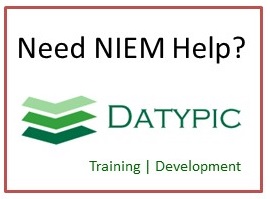gml:SurfacePropertyType
A property that has a surface as its value domain may either be an appropriate geometry element encapsulated in an element of this type or an XLink reference to a remote geometry element (where remote includes geometry elements located elsewhere in the same document). Either the reference or the contained element shall be given, but neither both nor none.
Complex type information
Namespace: http://www.opengis.net/gml/3.2
Schema document: external/ogc/gml/3.2.1/geometryBasic2d.xsd
Content
- Choice [0..1]
- gml:PolygonA Polygon is a special surface that is defined by a single surface patch (see D.3.6). The boundary of this patch is coplanar and the polygon uses planar interpolation in its interior. The elements exterior and interior describe the surface boundary of the polygon.
- gml:CompositeSurfaceA gml:CompositeSurface is represented by a set of orientable surfaces. It is geometry type with all the geometric properties of a (primitive) surface. Essentially, a composite surface is a collection of surfaces that join in pairs on common boundary curves and which, when considered as a whole, form a single surface. surfaceMember references or contains inline one surface in the composite surface. The surfaces are contiguous.
- gml:SurfaceA Surface is a 2-dimensional primitive and is composed of one or more surface patches as specified in ISO 19107:2003, 6.3.17.1. The surface patches are connected to one another. patches encapsulates the patches of the surface.
- gml:PolyhedralSurfaceA polyhedral surface is a surface composed of polygon patches connected along their common boundary curves. This differs from the surface type only in the restriction on the types of surface patches acceptable. polygonPatches encapsulates the polygon patches of the polyhedral surface.
- gml:TriangulatedSurfaceA triangulated surface is a polyhedral surface that is composed only of triangles. There is no restriction on how the triangulation is derived. trianglePatches encapsulates the triangles of the triangulated surface.
- gml:TinA tin is a triangulated surface that uses the Delauny algorithm or a similar algorithm complemented with consideration of stoplines (stopLines), breaklines (breakLines), and maximum length of triangle sides (maxLength). controlPoint shall contain a set of the positions (three or more) used as posts for this TIN (corners of the triangles in the TIN). See ISO 19107:2003, 6.4.39 for details.
- gml:OrientableSurfaceOrientableSurface consists of a surface and an orientation. If the orientation is "+", then the OrientableSurface is identical to the baseSurface. If the orientation is "-", then the OrientableSurface is a reference to a gml:AbstractSurface with an up-normal that reverses the direction for this OrientableSurface, the sense of "the top of the surface".
from subst. group gml:AbstractSurfacefrom subst. group gml:Surfacefrom subst. group gml:TriangulatedSurface
Attributes
| Name | Occ | Type | Description | Notes |
|---|---|---|---|---|
| xlink:type | [0..1] | xsd:string | Fixed value is "simple". from group xlink:simpleLink | |
| xlink:href | [0..1] | xsd:anyURI | from group xlink:simpleLink | |
| xlink:role | [0..1] | xsd:anyURI | from group xlink:simpleLink | |
| xlink:arcrole | [0..1] | xsd:anyURI | from group xlink:simpleLink | |
| xlink:title | [0..1] | xsd:string | from group xlink:simpleLink | |
| xlink:show | [0..1] | Anonymous | The 'show' attribute is used to communicate the desired presentation of the ending resource on traversal from the starting resource; it's value should be treated as follows: new - load ending resource in a new window, frame, pane, or other presentation context replace - load the resource in the same window, frame, pane, or other presentation context embed - load ending resource in place of the presentation of the starting resource other - behavior is unconstrained; examine other markup in the link for hints none - behavior is unconstrained | from group xlink:simpleLink |
| xlink:actuate | [0..1] | Anonymous | The 'actuate' attribute is used to communicate the desired timing of traversal from the starting resource to the ending resource; it's value should be treated as follows: onLoad - traverse to the ending resource immediately on loading the starting resource onRequest - traverse from the starting resource to the ending resource only on a post-loading event triggered for this purpose other - behavior is unconstrained; examine other markup in link for hints none - behavior is unconstrained | from group xlink:simpleLink |
| nilReason | [0..1] | gml:NilReasonType | from group gml:AssociationAttributeGroup | |
| gml:remoteSchema | [0..1] | xsd:anyURI | from group gml:AssociationAttributeGroup | |
| owns | [0..1] | xsd:boolean | Default value is "false". from group gml:OwnershipAttributeGroup |
Used by
- Element gml:baseSurface
- Element gml:extentOf
- Element gml:surfaceMember
- Element gml:surfaceProperty



